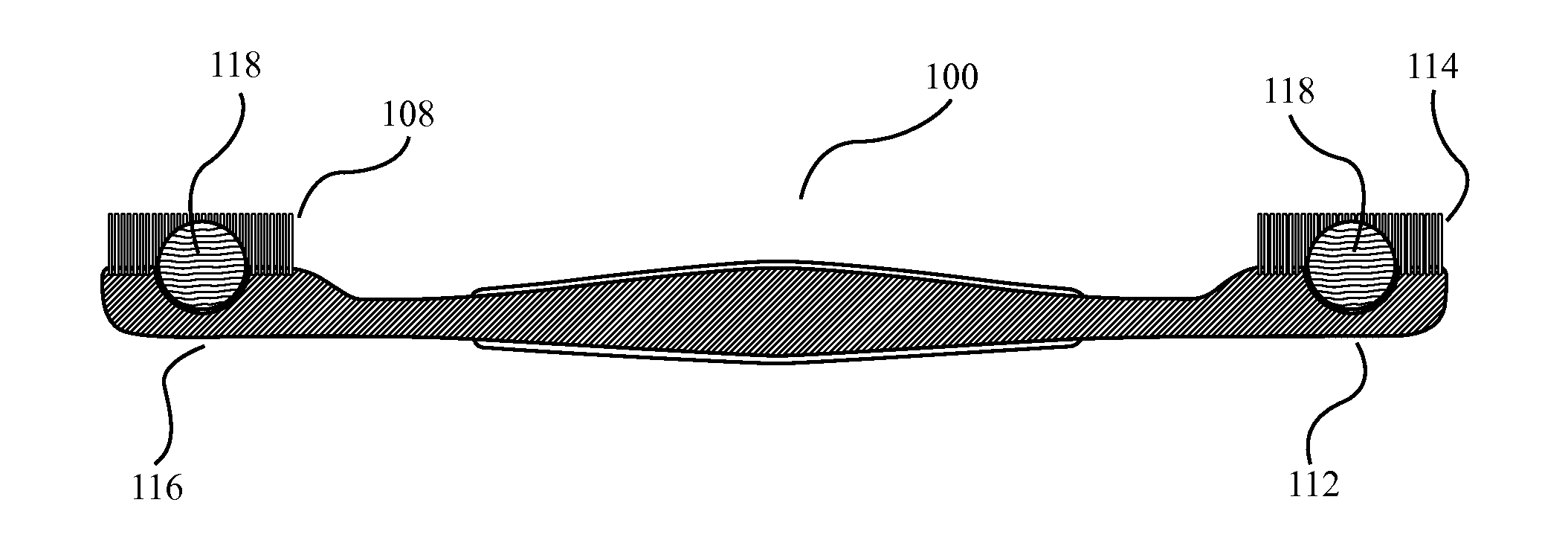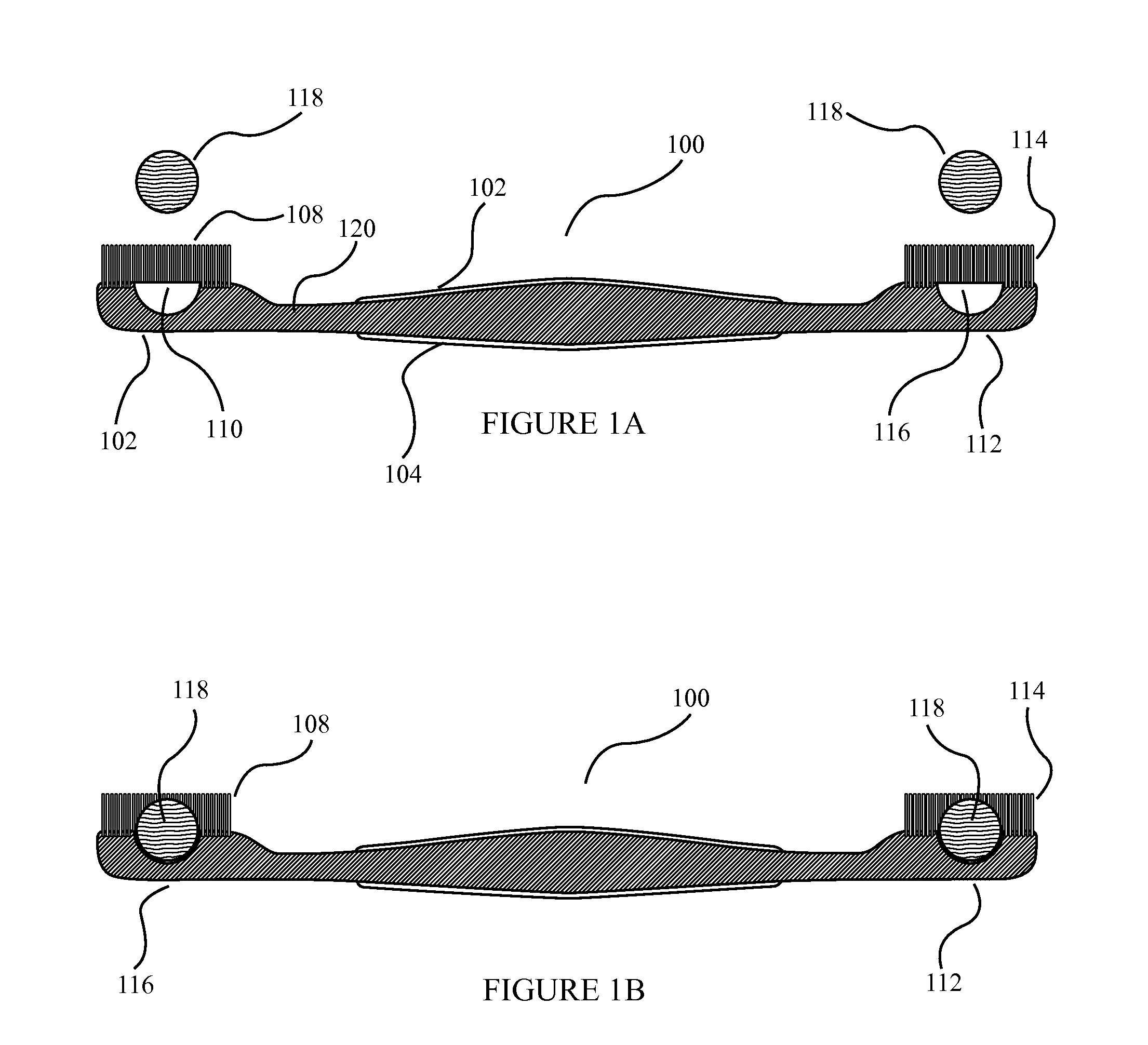In addition, tooth decay is the most common global
disease resulting from the generation of cavities inside pits and fissures on chewing surfaces where brushing cannot reach trapped and remaining food and
saliva or
fluoride have no access to neutralize acid and re-mineralize de-mineralized teeth.
Plaque accumulation causes the gingiva to become irritated and inflamed, resulting in the eventual loss of the
connective tissue fibers that attach the gums to the teeth and bone that surrounds the tooth (i.e.,
periodontitis).
Specifically, Lafortune claims that while certain toothbrushes in the art employ a
brush and
dentifrice disposed therein thereby eliminating the need for both a
toothbrush and a
toothpaste tube such toothbrushes have been intended for long-time use and as a result “complex and expensive solutions” to the refilling of the handles with
toothpaste have been implemented.
“Also, in the prior toothbrushes, valves have been used which prevent the expulsion and waste of
toothpaste and the contact of the toothpaste with air which would result in
caking” and “[s]uch valves add significantly to the cost of the toothbrushes.”
While the Lafortune disclosure is clearly an improvement over the existing art, it is limited to its short-term use.
Further, Lafortune is only useful for the application of toothpaste and does not employ a means to utilize additional
oral hygiene products such as mouthwash or the like.
Another possibility is the
antibacterial effect even without tooth paste.” While the
insertion of a “
polishing block” is clearly the novelty of the Durana disclosure, clearly such use of a soluble “
polishing block” can not be replenished once the block is depleted after one or more periods of use.
While clearly an improvement over the existing art, Frazell fails to explore and implement a
system comprising a dual-head design and means for providing a single compact unit for the dispersion of multiple oral
hygiene solutions.
Andersen claims that the device exhibits several advantages over the existing art as “it eliminates multiple users of the common tube of toothpaste, providing separate individual doses of toothpaste to each person” and it aids in the decrease of “the spread of disease between family members and toothpaste users.” While the Andersen disclosure is likely an improvement over the then-existing art as it potentially exhibits its intended objective, the Andersen disclosure fails to provide a
system comprising a dual-head design and means for providing a single unit for the dispersion of multiple oral
hygiene solutions.
Further, Andersen fails to provide a device capable of providing multiple
layers of oral
hygiene cleaning such as tongue cleansing or improved
bristle placement.
However, it will be readily apparent to one of ordinary skill in the art that Clark fails to disclose a dual-head design and means for providing a single unit for the dispersion of multiple oral hygiene solutions.
Further, Clark fails to provide a device capable of providing multiple
layers of oral hygiene cleaning such as tongue cleansing or improved
bristle placement.
Clearly, the Wong disclosure includes more than one layer of oral hygiene cleaning (i.e., a
toothbrush and an interdental
brush designed to “clean areas of the mouth inaccessible or awkward to reach with the main
brush”), however, Wong fails to provide a device capable of dispersing toothpaste or similar oral hygiene solutions.
Like several of the earlier disclosures, Wenzler fails to provide a device capable of dispersing toothpaste or similar oral hygiene solutions in conjunction with the multiple oral cleansing devices.
Further, Vazquez et al. fails to provide multiple cleaning implements for the application of more than one dentifrices such as toothpaste accompanied by a whitening gel or a mouthwash.
Finally, Vazquez et al. fails to provide a means for integrating common
dental floss or the like in a portable form in one integral unit.
However, Robinson et al. still fails to provide multitude heads to allow for the application of discreet application of a plurality of dentifrice or related agents.
Further, Robinson et al; fails to provide a plurality of cleaning implements to allow for
tongue cleaning, roof cleaning, or other regions of the
oral cavity, including hard to access regions.
In addition, Robinson et al. fails to provide a means for the release of
dental floss in one integral compact unit which is highly useful for personal at
home use or use during travel.
Specifically, none of the aforementioned references provide for a hygienic and compact dual head toothbrush capable of adequately dispersing various oral hygiene solutions, pastes, and / or gels designed for single or multi-use which exhibits an ease of manufacture and limited complexity of use.
 Login to View More
Login to View More  Login to View More
Login to View More 


